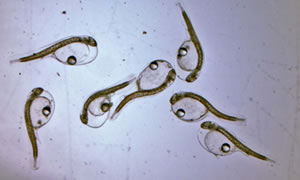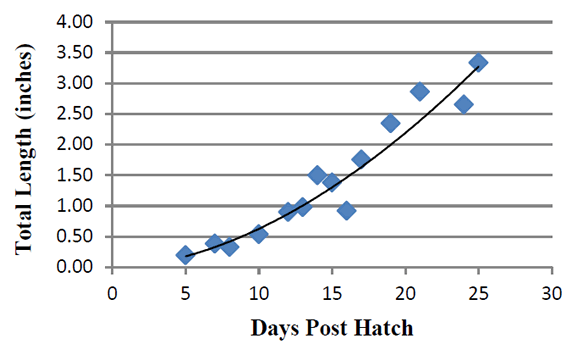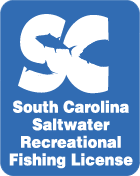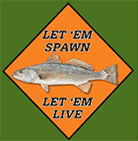Cobia Aquaculture Research
Cobia, Rachycentron canadum, is a recreationally important game fish and food species in South Carolina. Although cobia are caught offshore during all seasons of the year in South Carolina, fishing effort is primarily focused inshore during March through June in the state’s mid and southern high-salinity estuaries. Due to coastal development and accompanying increases in human populations, recreational fishing pressure on cobia has been increasing, especially in areas where they exhibit annual inshore aggregations. Within the past decade, cobia has been successfully farmed in Taiwan and China, and work is underway in the Caribbean and elsewhere to commercialize net pen culture of cobia. SCDNR was tasked with examining the potential for successful cobia aquaculture in South Carolina, thus providing a domestic product for consumers while reducing fishing "take" pressure on the stock.

In order to develop an aquaculture industry for cobia, two major research topics needed to be addressed. The first was the development of techniques for controlled spawning of captive broodstock, and the second was the production of juveniles in pond nursery systems. South Carolina was ideally suited to this research as adult cobia enter inshore waters in spawning condition. Researchers at SCDNR evaluated the reproductive potential of newly captured adults as well as those maintained and conditioned to captivity. Spawning occurred volitionally or was induced with the aid of hormonal injections. Once cobia were spawning, newly hatched larvae (fig. 1) were reared in outdoor nursery ponds at the Waddell Mariculture Center (WMC) in Bluffton, SC. In 2007 and 2008, researchers investigated survival, growth rate, and feed consumption of juvenile cobia reared at various pond stocking densities. Predictability of spawning, survival, and growth are important prerequisites for a successful aquaculture industry.
Brood fish used in 2007 and 2008 were captured by hook and line in the Broad River of Port Royal Sound. After capture, fish were transported in hauling tanks containing oxygenated water to a boat landing. Upon arrival the fish were off-loaded into a fish hauling trailer for transport to laboratory holding facilities at the Marine Resources Research Institute (MRRI) or the WMC. Maturation characteristics were used as a guide in selecting eligible spawners. Fish that produced sperm during abdominal compression were classified as mature males while needle biopsies were taken to determine sex and stage of development of fish that were not visibly running males.
A total of 23 fish were collected in 2007. Initially, males and females were held in separate outdoor 20’ diameter tanks at WMC and supplied with raw seawater from the adjacent Colleton River with a third 20’ tank set up for spawning trials. Tank effluent was discharged through an overflow pipe that emptied into an adjacent tank with a fine mesh net for collecting eggs. Fish readily adjusted to tank conditions with some fish actively feeding within days after being placed into the tank. Following the 2007 spawning trials, brood fish were transported to 12’ diameter indoor tanks with controlled lighting and water temperature at MRRI in Charleston for use in conditioning trials in 2008. A total of 18 fish were collected in 2008 for additional spawning trials with newly captured adults.
Two spawning hormones were investigated for use with cobia. Human Chorionic Gonadotropin (hCG) is an FDA approved spawning aid, while the synthetic Gonadotropin Releasing Hormone analogue (GnRHa) is an investigational new animal drug. Female cobia who reached a suitable stage of development were given an injection of one of the spawning aids and paired with 3 males in the spawning tank. Spawns typically occurred in the evenings within 36 hours of injection. Spawned eggs were removed from collection nets on mornings following spawns and enumerated volumetrically. Not all eggs spawned are considered viable. Some eggs do not become fertilized while others are fertilized but don’t develop normally. These eggs sink while viable eggs float, allowing researchers to separate good eggs from bad eggs. Only viable eggs were transferred to hatching cones for incubation. A total of 22 cobia spawns were collected in 2007 and 2008 producing a total of over 11 million viable eggs (table 1).
Table 1. Hormone injection and egg production during cobia spawning trials
| Year | Broodstock | Hormone | Spawns (n) | Eggs (n) | Viable Eggs (n) | Viability |
|---|---|---|---|---|---|---|
| 2007 | Newly Captured | hCG | 4 | 4,318,444 | 1,571,640 | 36% |
| 2007 | Newly Captured | GnRHa | 5 | 3,347,400 | 2,440,200 | 73% |
| 2007 | Newly Captured | none | 3 | 1,810,200 | 1,369,200 | 76% |
| 2008 | Newly Captured | hCG | 2 | 660,000 | 0 | 0% |
| 2008 | Conditioned | hCG | 3 | 3,200,000 | 1,200,000 | 38% |
| 2008 | Conditioned | GnRHa | 5 | 8,500,000 | 4,600,000 | 54% |
| Total | 22 | 21,836,044 | 11,181,040 | 51% |
Eggs hatched in larvae within 16 hours of being spawned. For the first 3 days, larvae are nourished by a yolk sac as their eyes, mouth, and stomach continue to develop to the point they can capture prey. It is during this yolk sac phase that larvae are enumerated, transported to, and stocked in the outdoor nursery ponds where they are grown into small juveniles known as fingerlings. The number of larvae stocked in a pond divided by the area of the pond is known as pond stocking density. In 2007 and 2008 a total of 44 ponds at the Waddell Mariculture Center were stocked with over 2 million cobia larvae in order to examine the effect of stocking density on survival (table 2).
Table 2. Pond production of cobia fingerlings.
| Density (larvae/ha) | Ponds (n) | Larvae (n) | Juveniles (n) | Survival (%) |
|---|---|---|---|---|
| < 200,000 | 11 | 403,500 | 32,598 | 8.08% |
| 200,000-250,000 | 13 | 472,500 | 32,919 | 6.97% |
| 350,000-400,000 | 11 | 540,000 | 10,958 | 2.03% |
| 700,000 | 9 | 945,000 | 8,802 | 0.93% |
| Total | 44 | 2,361,000 | 85,277 | 3.61% |
In addition to spawning and pond production, researchers investigated what cobia were eating in the ponds and how fast they were growing. Outdoor nursery ponds are managed to create natural blooms of algae and small aquatic insects known as zooplankton. In addition, managers hatched and fed live brine shrimp to supplement the natural feed. Finally, when the fish had grown large enough, a pelleted commercial fish diet was offered as feed. An examination of the stomach contents of fish collected from the production ponds revealed that natural zooplankton was the predominant food source from age 5 days to age 16 days. Cobia began to consume the live brine shrimp at about day 10 and transitioned to the commercial diet by day 20. During the first month of life, cobia grew very quickly. They averaged 1 inch after 12 days, at which time they could be seen (by managers and birds alike) swimming on the surface of the ponds. When ponds were harvested after 25 days cobia had tripled in size to an average of 3 inches.

Research into spawning techniques and pond production of cobia in South Carolina proved to be successful. Wild cobia collected in the Broad River were captured in spawning condition and spawned on their own without the need of spawning aids on a few occasions; however such events could not be reliably predicted. In order to improve predictability of spawns, cobia could be induced to spawn with FDA approved spawning aids, although experimental spawning aids produced more viable eggs. Cobia held in captivity for one year could be conditioned to spawn in indoor tanks further reducing the dependence on wild captures and increasing predictability. Cobia larvae stocked in outdoor nursery ponds grow quickly (fig. 2) and rely upon natural prey items; therefore ponds stocked at high density may become food-limited, leading to lower survival. While winter water temperatures are too low to support net pen aquaculture, outdoor pond culture in South Carolina could find a niche in the industry by providing commercial producers with seasonal seed stock for net pens located in the Caribbean.



